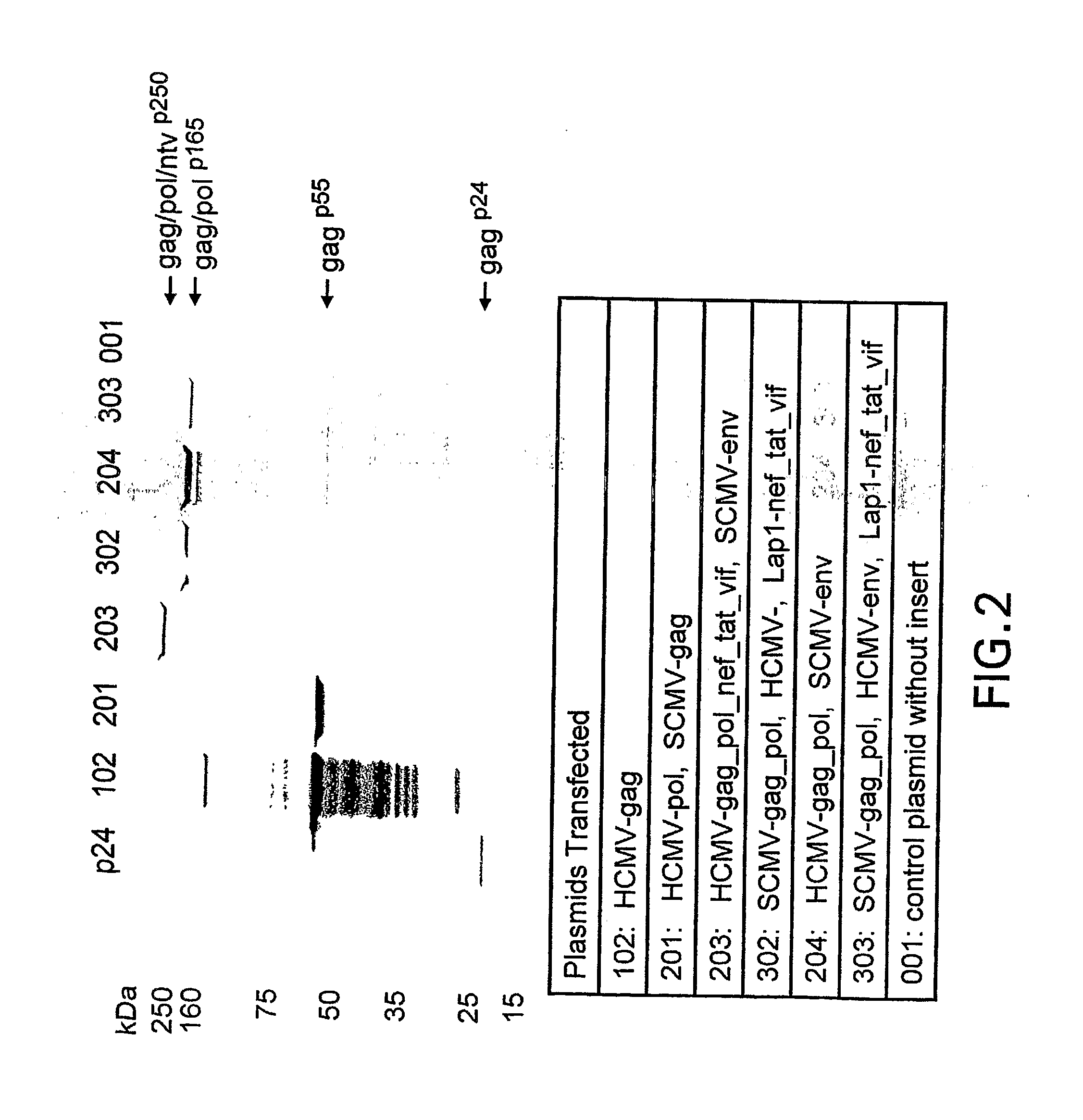Plasmid having three complete transcriptional units and immunogenic compositions for inducing an immune response to hiv
a technology of immunogenic composition and plasmid, which is applied in the field of plasmids and immunogenic compositions, can solve the problems of limiting the expression of multiple genes from one vector backbone in a single target cell, raising safety and technical issues, and difficult to achieve optimal expression of all encoded genes
- Summary
- Abstract
- Description
- Claims
- Application Information
AI Technical Summary
Benefits of technology
Problems solved by technology
Method used
Image
Examples
example 1
Selection and Modification of HIV Genes
[0179] One of skill in the art would appreciate that sequence information from many viruses and bacteria is available in the art. More particularly, sequence information can be used to clone genes for use in expressing polypeptides in plasmids of the invention. Information on many sequences from HIV and other pathogens is available from the HIV sequence database at the Los Alamos National Laboratory and the National Center for Biotechnology Information at the United States National Library of Medicine, (8600 Rockville Pike, Bethesda, Md. 20894).
[0180] In one embodiment of the invention, the following HIV genes were selected for inclusion into a single exemplary DNA plasmid expressing most of the HIV genome: gag gene from the HXB2 isolate and the pol gene from the HXB2 isolate. The complete HXB2 sequence is listed in the GenBank computer database under the accession number K03455. The nef, tat and vif genes were derived from the NL4-3 isolate....
example 2
Construction of Single, Double and Triple Transcriptional Unit Plasmids
[0191] The plasmids discussed in these examples are set forth in Tables 1 and 2.
[0192] A triple transcriptional unit expression cassette was constructed by using a variety of components in a circular double stranded DNA plasmid. See FIG. 1. The first component was a first transcriptional unit for expressing polypeptides in eukaryotic cells, composed of the simian cytomegalovirus (SCMV) promoter, a cloning site and bovine growth hormone (BGH) poly-A signal. The second component is a second transcriptional unit for expressing polypeptides in eukaryotic cells, which consists of human cytomegalovirus (HCMV) immediate early promoter, a cloning site and the SV40 polyadenylation (polyA) signal. Separating the first and second transcriptional units is spacer region 1. The third component is a third transcriptional unit for expressing polypeptides in eukaryotic cells and is composed of the Herpes simplex virus Lap1 prom...
example 3
Triple Transcriptional Unit Plasmid Containing Six HIV Genes
[0193] As a demonstration of the use of the three transcriptional unit plasmid DNA vectors, a plasmid vector capable of co-expressing three eukaryotic open reading frames was created. The three transcriptional unit plasmid DNA vector was created by inserting the following selected genes encoding HIV-1 antigens into the triple transcriptional unit expression cassette described in Example 2. All cloning techniques were performed following conventional procedures (Sambrook et al. 1989).
[0194] First, an HIV-1 gag-pol fusion gene was inserted into the PmeI-XhoI cloning site between the SCMV and BGH poly-A sites of the first transcriptional unit. The gag gene was derived from the HXB2 isolate, and, similarly, the pol gene was also derived from the HXB2 isolate. The complete HXB2 sequence is listed in the GenBank computer database under the accession number K03455. One of skill in the art would understand that other HIV-1 gag an...
PUM
| Property | Measurement | Unit |
|---|---|---|
| Dielectric strength | aaaaa | aaaaa |
| Dielectric strength | aaaaa | aaaaa |
| Volume | aaaaa | aaaaa |
Abstract
Description
Claims
Application Information
 Login to View More
Login to View More - R&D
- Intellectual Property
- Life Sciences
- Materials
- Tech Scout
- Unparalleled Data Quality
- Higher Quality Content
- 60% Fewer Hallucinations
Browse by: Latest US Patents, China's latest patents, Technical Efficacy Thesaurus, Application Domain, Technology Topic, Popular Technical Reports.
© 2025 PatSnap. All rights reserved.Legal|Privacy policy|Modern Slavery Act Transparency Statement|Sitemap|About US| Contact US: help@patsnap.com



